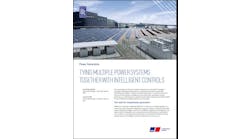Granny was thrown out of her wheelchair and off a cliff in one of the most controversial ads of the 2012 US presidential election. Whether you love or hate the clip, which went after Republicans on Medicare, it shows the emotional tenor we bring to the debate over health care costs.
Energy costs affect Granny at least as much – and everyone else too. Yet we rarely devote such time and passion to the issue, except when gasoline prices spike. Even then, the talk is temporary. We become acclimated to the higher costs. Note how little grumbling you hear now that $3-$4 per gallon gasoline is the new normal.
Why do we make a big deal about the economics of health care and not the economics of energy? Because we are not doing the math. That’s what a new report by United Technologies Corp. reveals.
Few realize, for example, that we spend about the same amount each year powering our homes, stores and offices – $432 billion – as businesses spend on health insurance.
“It is on par, which is remarkable because it speaks to where we can go,” said John Mandyck, chief sustainability officer for UTC Climate, Controls and Security, in an interview.
Where UTC sees us going is toward saving money through greater energy efficiency, which opens the way toward deploying the extra capital for other personal or investment purposes.
“Unlocking American Efficiency: The Economic and Commercial Power of Investing in Energy Efficient Buildings,” looks specifically at the economics of making US buildings 30 percent more efficient by 2030. Here are a few eye-catching points the report makes about what that could mean for our finances.
- A 30% investment in building efficiency brings a 28.6 percent internal rate of return over 10 years. That’s about four times better than average corporate bond yield or average equity performance and more than double the returns of high performing venture capital firms.
- Households could save about $466 per year – twice as much as they spend on average for fresh vegetables and nearly as much as they spend on prescription and non-prescription drugs.
- After recouping the cost of upgrading government buildings, the US would save about $8 billion per year on energy costs. How meaningful is this? Over a decade, this is as much savings as we could achieve by raising the Medicare retirement age to 67, increasing taxes one percent for top earners, or taxing foreign earnings by US corporations. It’s also about as much as we would save by eliminating the Environmental Protection Agency.
Here is another way to look at energy savings. Think about lowering energy costs as a way to raise household income, says the report. We hear a lot about the decline in middle class salaries. Had energy costs remained level since 2000, they would have made up for the average drop in household income.
Thinking about energy costs this way converts the issue from being “a problem to an opportunity,” Mandyck said. It offers a chance to consider how we can “redeploy that cash flow in other ways.”
It makes sense for the US to pursue this line of thought with greater vigor. As a share of gross domestic product, energy costs rose from 6.2 percent to 9.2 percent over the last decade, says the report. And we can expect to see energy costs rise another 17% over the next two decades, according to the International Energy Agency.
Ultimately, the UTC’s energy efficiency story is about us keeping more of our own money and using it in other productive ways. Granny’s wheel chair doesn’t need to be powered by a heartless force beyond her control that sends her over a cliff. Embed more energy efficiency into the economy and Granny can afford her own motorized, self-propelled wheelchair and go wherever she wants.





